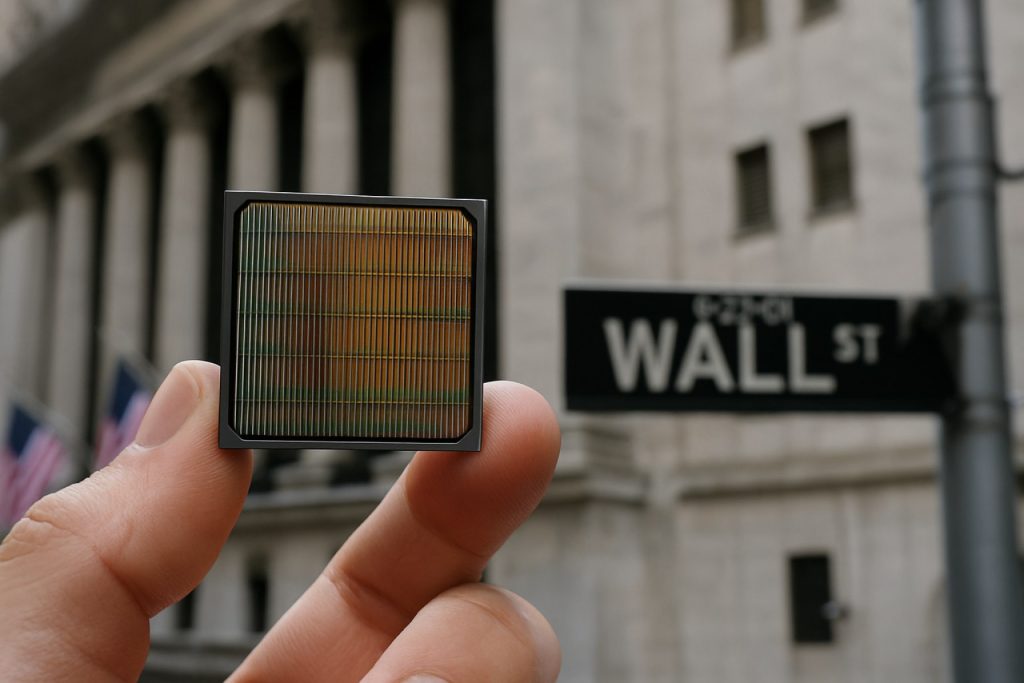
- Navitas Semiconductor’s stock soared after news of a partnership with Nvidia, despite its modest revenue and ongoing losses.
- The company specializes in power semiconductors based on gallium nitride (GaN) and silicon carbide (SiC), not traditional silicon.
- GaN and SiC chips offer higher efficiency, smaller size, and better heat management—crucial for next-generation AI data centers.
- Nvidia plans to use Navitas’s advanced chips in its upcoming Rubin Ultra supercomputing platform to address the energy demands of AI.
- Navitas has a strong pipeline of future contracts, positioning it to benefit if AI-driven power needs continue to grow.
- The push for efficient semiconductor technology is rapidly reshaping the data center and AI markets, with innovators like Navitas at the forefront.
A quiet storm surged across Wall Street as Navitas Semiconductor’s stock catapulted upward, its value almost doubling within a matter of hours. The world watched, puzzled, as the ticker NVTS blazed, far outpacing the likes of established rivals. Rarely does a relatively obscure chipmaker, operating on dwindling sales and heavy losses, leap into the limelight so quickly. But behind the market drama, a more profound story unspooled—one about the relentless search for efficiency in an energy-hungry, AI-driven world.
Navitas crafts its identity on a promise: to usher in a new generation of power semiconductors. While the semiconductor industry has worshipped at the altar of silicon for decades, Navitas takes a bold detour. Its power chips are built on gallium nitride (GaN) and silicon carbide (SiC)—exotic materials that promise to not only upend expectations, but to fundamentally change the way power moves through our digital infrastructure. In consumer gadgets, the company claims a charger no bigger than a matchbox can pump energy into a phone three times faster than a silicon-based version. But the true stage for this technology is much grander.
Attention swelled when Nvidia, the undisputed colossus of AI hardware, inked a partnership with Navitas. Rather than a whim, this alliance is a calculated move to crack the looming power conundrum in AI data centers—a challenge that will only grow as demand for faster, smarter AI models balloons. Nvidia’s future supercomputing architecture, code-named Rubin Ultra, will lean on Navitas’s GaN and SiC power chips to reimagine how energy courses from the grid through the server, feeding the voracious appetite of next-generation AI processors.
Why the urgency? Traditional data centers rely on a series of voltage conversions—a step-by-step, energy-leaking chain that shaves away efficiency at every transformation. Each conversion, typically managed by beefy silicon chips, gobbles up precious electricity and real estate inside server racks. As AI workloads multiply, so does the pressure to streamline this energy channel—delivering more power in less space, with fewer losses.
Here, Navitas steps into the breach. GaN and SiC can be crafted into power chips that thrive at high voltages, maintain compact size, and run cool under pressure. For companies like Nvidia, this means servers that can pack more AI brains in every square inch, using less electricity and shrinking the ecological and financial cost of artificial intelligence. This strategy isn’t just clever engineering; it’s an imperative as the world pivots toward Nvidia-powered intelligence, spreading from driverless cars to quantum computers.
Yet, this technological prowess does not immediately translate into booming balance sheets. Navitas has posted weak revenues—barely $74 million over a year, with sales sliding and painful losses mounting. The core challenge: Manufacturing GaN and SiC chips is more expensive and complex than tried-and-true silicon. Many customers are still hesitant, unwilling to pay a premium before seeing ironclad, large-scale results.
Nevertheless, forward-looking investors and analysts smell a seismic shift in the works. Navitas has accumulated a pipeline of $450 million in design wins—contracts expected to mature into real sales by 2026 and 2027. If AI’s astronomical power needs continue to surge, as industry leaders predict, the market for these high-performance chips could explode in parallel. Navitas’ long-standing bet on gallium nitride and silicon carbide now seems prescient, rather than quixotic.
With Wall Street’s eyes peeled for the company’s next earnings report and whispers of more partnerships circulating, Navitas becomes a microcosm of a larger, exhilarating trend: Technology is evolving rapidly, and the winners will be those who reimagine the unseen foundations—down to the very electrons pulsing through each microchip.
The takeaway? Navitas Semiconductor exemplifies how unassuming innovators can unlock massive new value when their technology finds the right moment to strike. In the fierce race to fuel the world’s AI ambitions efficiently, all eyes are now on the silent revolutions brewing far beneath the surface.
For those curious about how AI and semiconductor technology continue to shape our digital world, visit Nvidia and Navitas Semiconductor for deeper insights.
Why Navitas Semiconductor’s AI Surge is Just the Beginning: 10 Hidden Facts & Actionable Insights for Investors
Introduction
Navitas Semiconductor (NVTS) just shocked the market with a dramatic stock surge, captivating investors and tech observers worldwide. But the story runs deeper—powered by emerging materials, big-name AI partnerships, and an industry at a crossroads. Here’s what you need to know about Navitas, gallium nitride (GaN), and silicon carbide (SiC)—plus exclusive expert insights, industry trends, and what it all means for your portfolio.
1. What Makes GaN & SiC Power Chips So Disruptive?
- Higher Efficiency and Power Density: GaN chips can switch up to 10x faster than silicon, handle higher voltages, and reduce power losses, especially critical in AI data centers (IEEE study).
- Compact Designs: GaN and SiC allow for smaller, lighter chargers and power modules, which is revolutionizing everything from phone chargers to electric vehicles (EVs).
- Cus–tom Cooling & Reliability: SiC chips withstand higher temperatures and harsh environments, extending equipment lifespan in industrial and automotive settings (Infineon fact sheet).
2. Rapidly Growing Markets & Use Cases
- Data Centers: Power management is now the top obstacle for scaling AI workloads; Nvidia’s partnership aims at tackling this inefficiency head-on.
- EVs & Renewable Energy: GaN/SiC chips are crucial for faster charging, longer battery life, and efficient solar inverters (STMicroelectronics overview).
- Consumer Tech: Leading brands like Dell, Lenovo, and Xiaomi have shipped GaN-based chargers and adapters to millions of users in the past two years.
3. Financials & Market Forecast
- Revenue Challenge: While Navitas’ 2023 revenue ($74 million) remains modest, analysts at Bloomberg and Citi predict compound annual growth rates (CAGR) for the GaN/SiC sector of 25-40% through 2030.
- Design Pipeline: A $450 million design win backlog signals major sales potential in 2026–2027 (company filings).
- Relative Valuation: Competitors like Wolfspeed and Infineon trade at much higher multiples, hinting at future upside if Navitas proves its model.
4. Review: Features, Specs & Pricing Comparison
- Navitas NV6 Series chips operate up to 650V, switching at MHz frequencies, with industry-leading power densities.
- Cost Premium: GaN and SiC chips are currently 20–50% more expensive to manufacture than silicon, but prices are falling rapidly as scale increases and factory yields improve (source: Navitas Semiconductor).
- Long-Term TCO: Energy savings can offset the initial price premium in high-use scenarios like data centers.
5. Controversies & Limitations
- Manufacturing Bottlenecks: Current supply chains for GaN/SiC wafers are immature, creating risks of shortages and high initial costs (Semiconductor Industry Association).
- Customer Caution: Enterprise customers want real-world, long-term reliability proofs, slowing mass adoption despite tech advantages.
- Competition: Industry giants (Infineon, STMicro, Texas Instruments) are heavily investing, making sustained leadership uncertain.
6. Security & Sustainability
- Eco-Friendly Claims: Navitas estimates that replacing silicon with GaN could save up to 2.6 Gtons of CO2 emissions globally from 2023–2050—a major attractor for ESG-focused funds.
- Cyber-Security: Navitas’ chips are power management components, so direct risks are low, but as data centers consolidate power infrastructure, new attack surfaces could emerge.
Life Hacks, How-To Steps & Real-World Applications
- How-To Upgrade: To speed-charge your devices, look for chargers marked “GaN”—delivering more power without bulky adapters.
- For Data Center Operators: Start pilot programs using GaN/SiC power conversion modules; energy and space savings can justify initial outlays.
- For Investors: Monitor quarterly design win announcements and customer adoption pace for early indicators of revenue inflection.
Pros & Cons Overview
Pros:
- Massive efficiency boost at both consumer and industrial scale
- Pivotal for AI, EV, and clean energy megatrends
- Backed by industry leaders (Nvidia partnership is a major vote of confidence)
- Strong ESG credentials
Cons:
- Still unprofitable and reliant on future pipeline materializing
- Manufacturing remains costlier than legacy technology
- Heavy competition from bigger, resource-rich players
FAQ: Most Pressing Reader Questions
Q: Is Navitas a safe investment?
A: Navitas is a high-risk, high-reward bet. If design wins convert to sales and GaN/SiC adoption accelerates, upside is significant. Risk-averse investors should observe revenue trends and customer wins before diving in.
Q: Are GaN and SiC here to stay?
A: Yes—industry consensus is that these materials will power the next generation of AI, EVs, fast chargers, and green energy systems (>80% CAGR projected by Yole Group through 2030).
Q: Won’t bigger chipmakers crush Navitas?
A: Large players are investing, but Navitas’ pure-play focus and nimbleness could secure niche wins, or make it an acquisition target down the line.
Actionable Recommendations & Quick Tips
- If you run a data center, explore small-scale GaN/SiC integration pilots for measurable efficiency gains.
- Tech enthusiasts: Upgrade your phone/laptop charger to GaN for safer, faster charging.
- Investors: Follow earnings calls, design win updates, and major customer partnerships to spot momentum shifts early.
- ESG-focused investors: Monitor Navitas for green technology breakthroughs and upcoming reports on emissions impact.
Conclusion: Navitas—Worth Watching in the AI-Driven Power Revolution
As the world’s AI ambitions escalate and energy efficiency becomes king, innovators like Navitas Semiconductor are primed for breakout success. But in this race, execution, partnerships, and reliable scaling will separate the real disruptors from the hype. Stay informed by visiting Nvidia and Navitas Semiconductor for the latest updates.
With smart research and nimble moves, today’s breakthrough could be tomorrow’s blue-chip—don’t miss the electrifying opportunities powering the next tech era.



